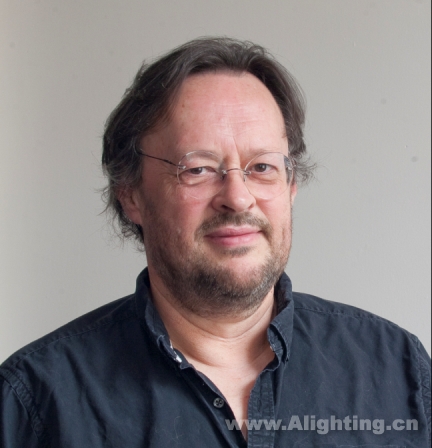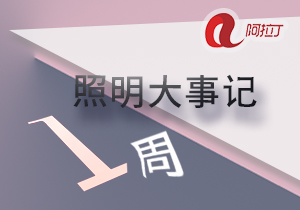KEVAN SHAW
IALD Professional Member
国际照明设计师协会专业会员
PLDA Director of Sustainability
原专业照明设计师协会可持续发展理事
KSLD Design Director
KSLD设计总监
Professor at Hochschule Wismar, Germany 德国魏斯玛大学教授/讲师
Professor at Edinburgh Napier University, Scotland 苏格兰爱丁堡龙比亚大学教授/讲师

Kevan was born and raised in Edinburgh, Scotland. He graduated from
Loughborough University of Technology with a BSc in Economic and Technological
History and Social Psychology in 1975. Kevan began his career as a lighting
designer for rock bands including Jethro Tull, Ultravox, XTC and Steve
Hackett.
Kevan于苏格兰爱丁堡出生并长大。1975年,他毕业于拉夫堡技术大学,获经济与技术史、社会心理学双学士学位。他的照明设计生涯缘起于为一些摇滚乐队做灯光设计。
In 1985 he forsook life on the road to realise some long-standing ideas in lighting effects equipment, developing a theatrical lighting effects system for DHA Lighting in London. At this time his lighting design work focused on TV and video projects, including ETC, a live music series for Channel 4, and the MTV World Music Video Awards. He also developed a number of architectural and exhibition lighting schemes at DHA.
1985年是他的人生转折点,对灯光设备的误区有了长足的认识,逐渐为伦敦DHA灯光公司发展出一套戏剧化的舞美系统。当时,他的主要设计工作是关于电视与电台的项目,包括电视频道的音乐真人秀、MTV世界音乐音频大典等。同时期,他也参与了很多建筑与展示照明的设计。
In 1989 Kevan returned to his native town of Edinburgh to practise as a lighting designer in the architectural and exhibition area, establishing KSLD. He has led the KSLD team on over 590 projects. While all valuable in their way, Kevan identifies the following projects as being particularly significant for KSLD.
1989年,Kevan回到家乡爱丁堡,创建自己的公司KSLD,从事建筑照明与展示照明的设计。迄今为止,他和他的团队已经完成了大大小小590多个项目,广受好评。其中最有代表性的有:
The Art Lover’s House, Glasgow (1989) 艺术爱好者的家,格拉斯哥(1989)
The Public Institute for Social Security, Kuwait (2001) 社会公共安全研究所,科威特(2001)
Alighting: You began your career as a lighting designer for rock bands. What was the work like? Could it be interpreted as stage lighting?
《阿拉丁》:您开启灯光设计的职业生涯是从摇滚乐队开始的,那是一份什么样的工作?可以理解为舞台灯光吗?
Kevan Shaw: This was most definitely stage lighting. I was touring with bands and tended to be responsible for technical as well as design issues. This is a big learning experience and develops a lot of problem solving skills. The design included operating the show so being involved in the musical performance. I was very interested in relating the stage aesthetic to the music and lyrics in a theatrical way, whilst paying a lot of attention to rhythm and dynamics.
K.S.:是的,就是舞美。我跟随乐队巡演,负责灯光有关的设计与技术。那是一个很大的学习机会,让我累积了丰富的经验与设计技巧。灯光舞美参与并融入音乐表演。我对灯光与音乐和歌曲的戏剧性联接方式很感兴趣,也非常注意灯光的节奏与力度。
Alighting: You have works of many types, such as stage lighting, exhibition lighting, architectural lighting and light art installations. Which attracts you the most? Why?
《阿拉丁》:您的作品涵盖了舞台灯光,展示照明,建筑照明,灯光装置等等。哪个领域是您最感兴趣的?为什么?
Kevan Shaw: The great thing about lighting is that all these varied areas bring different experiences. Each of them has their own attractions so I find it difficult to say that any one attracts me more than the other. What I enjoy is the learning and discovery that every form of lighting brings in abundance with new things to light and new technologies to light with.
K.S.: 灯光最棒的就是所有这些不同的领域都能给你带来不一样的体验。每一个类别都有其各自的魅力,所以,我很难说喜欢哪种灯光多一些。我很享受学习和发现不同的灯光形式所带来的新载体和新技术。
Alighting: You have been in the lighting industry for over 30 years. What’s the biggest change of both the industry and yourself?
《阿拉丁》:您从事照明行业30余年,经历的个人及行业最大变化是什么?
Kevan Shaw: I think there have been several. Probably the most important has been the gradual acceptance that the independent lighting designer has become a recognized part of the building design team. When I started out in architectural lighting I had to explain exactly what I was bringing to a project every time, these days most architects and engineers have previously worked with a lighting designer so the conversation is a bit easier.
K.S.: 我认为还是有不少变化的。最重要的变化也许是对于独立灯光设计师作为建筑设计团队的一部分的认知已逐渐被接受。当我刚开始从事建筑灯光设计时,每次都得详尽解释我能为建筑设计带来什么。如今大部分建筑师与工程师都有过与灯光设计师合作的经验,因此对话起来就容易多了。
Technologically I have seen the rise and fall of many different products and technologies over my career. Certainly the focus on energy efficiency has grown and legislation increased. I have to spend much more time on compliance and understanding how to achieve the requirements now. As in every area of life, technology has become increasingly complex. This has all been part of the continuous learning process that is lighting design. Back in the 80s low voltage lighting with transformers was new technology, now we are close to having a computer inside every light fitting to control LEDs!
从技术上来说,我的职业生涯中已经看到过太多产品与技术的起落。当然,对节能的关注与相关行业的立法都有所增长。我现在必须花更多的时间去理解、遵从这些设计规范和要求。就如同生活中的每一个领域,技术已经变得越来越复杂,这一切都成为不断学习照明设计过程的一部分。早在上世纪80年代,带变压器的低压照明已经是新技术了,而现在,我们就差没在每个灯光装置里面置入一台“电脑”来控制所用的LED灯了!
For myself, I feel older in body but lighting design keeps my young and enquiring in mind and spirit.
对我自己而言,虽然生理年龄渐长,但灯光设计让我保持心理与精神的年轻!
Alighting: Many of your articles focus on technology and some of them concern about LED. What do you think of the future of lighting technology?
《阿拉丁》:您写了很多关于技术与LED的文章,对于照明技术的未来前景,您是如何看待的呢?
Kevan Shaw: I do think we are seeing a very unstable market with products claiming operating lives of 15 to 25 years; however these only stay available for a year or so without being changed or upgraded. The problems include trying to write a specification during design for a project where construction is 1 or 2 years ahead, frequently the products you have specified are no longer available. The other issue is that we have been used to lighting equipment that can last 30 years or more and changing the failing component, the lamp at regular intervals. Now we are putting in schemes that we expect to have reached end of effective life after 10 to 15 years, at which point there is no replacement but the scheme will need to be replaced in its entirety. This is the same kind of planned obsolescence that exists in the consumer domain though on a longer time frame than your computer, mobile phone or car. I think we are still being promised too much. A lot of products that will never materialize in the way we are led to expect, OLED for general lighting is one of the big ones.
K.S.: 我确实认为我们面对的是一个十分不稳定的市场,有些产品宣称有长达15至25年的寿命,但是如果这些产品不升级,那在项目中的实际使用年限也只一年左右。当我们试图为项目拟写设计规范时,如果项目的建设期是1至2年,那届时指定的产品可能已经不生产了。另一个问题是,我们已经习惯了使用寿命30年及以上的产品,定期维修,更换损坏元件与灯泡。现在,我们将预期10至15年寿命的产品设计入方案,届时没有可更换的产品,则整个设计方案都需要被替换。这会是有计划的淘汰,在电脑、手机、汽车等消费领域是已经普遍存在的现象。我想,我们被承诺得太多了。很多产品将永远不会如我们所期望的实现,比如OLED作用于普通照明就是其中之一。
Alighting: What do you think is the most important factor in lighting design?
《阿拉丁》:您认为照明设计最重要的因素是什么?
Kevan Shaw: Understanding how people see and react to the lighting you are designing. This is another area with a lot of new information developing, much from the rediscovery of the third photoreceptor and the implications on health and wellbeing of how the lighting we design can affect the pattern of sleep and probably other systems that we are still learning about.
K.S.: 理解人们如何看待你的设计,并会如何反应。这个领域有很多新的信息,来源于第三感光的重新发现,灯光对健康的影响,我们设计的灯光如何影响睡眠模式,以及其他我们正在研究学习的系统等等。
Understanding how we see is also a developing area. Just this week we have seen the internet show this with the meme of the dress. Different people see this image either as white and gold or as blue and black, this will doubtlessly result in some interesting research and new information on how we see.
理解和研究人类如何“看”也是一个正在发展的领域。就在不久前我们看到互联网上传播的那件“迷一样”的衣服。同一件衣服不同的人却会看出白金和蓝黑两种完全不同的颜色,这毫无疑问会引起有关人类如何“看”的话题研究,并出现一些新的信息和论点。
Alighting: What is your design philosophy?
《阿拉丁》:您的设计理念是什么?
Kevan Shaw: We have a practice philosophy “Sharing the Light”. This is about gaining an understanding of what the client or design team want to see and also sharing our knowledge and experience of light and lighting with them and others including students of lighting.
K.S.:我们有个实操理念,叫“光分享”。目的是理解客户或设计团队想要看到的是什么,同时,把我们在灯光与照明上的知识与经验分享给他们,包括学生在内的其他人们。
Alighting: How to balance the functionality and aesthetics in lighting design?
《阿拉丁》:您是如何兼顾灯光设计中的功能性与美学性?
Kevan Shaw: On a knife edge! This is really where our knowledge and skills come to the forefront. Each project will require this balance subtly altering to achieve both a beautiful and practical result.
K.S.: 走在刀刃上!这正是展现我们知识与技能的竞技场。每个项目都需要这样的平衡,通过一些细节的巧妙处理,达到美观与实用的双重效果。
Alighting: Have you ever been to China? How do you like the urban lighting design in China?
《阿拉丁》:您到访过中国吗?如何看待中国的城市照明现状?
Kevan Shaw: I have been a few times. There are some very spectacular and visually busy lighting installations. I think this shows a rather young and excited approach to the available technologies reflecting the very rapid economic development of the country. I cannot say whether it is good or bad, you need to ask the people who live with it, do they like it and enjoy it?
K.S.: 我去过中国好几次。有些城市的夜景照明看起来非常壮观,而且非常热闹。我想,这种对可用技术显现出年轻而兴奋的趋向性,也反应出中国经济的飞速发展。我无法说这是好还是坏。这个问题应该问城市居民,他们是否喜欢身边的灯光。
Alighting: What do you think of the lighting profession in Europe?
《阿拉丁》:欧洲的照明设计职业发展现状如何?
Kevan Shaw: I think it is still developing. There has been a bit of a setback due to the economic situation over the past five or six years. It is growing in maturity and there are some good education programs bringing younger people into the profession with a good fundamental knowledge of lighting. I think there remains a lot of scope for further development given some stability returning to the economies in Europe.
K.S.: 我认为还是在持续发展的。过去的五六年间,由于经济的衰退也呈现出一定程度的倒退,但是行业是在不断地成熟,现在有一些很好的教育项目,吸引了有良好照明基础知识的年轻人从事这个职业。我想,待欧洲恢复经济,这个行业将会有很大的发展空间。
Alighting: Did you do the lighting design for your own house? What is it like?
《阿拉丁》:您有为自己的房子做灯光设计吗?它是怎样的?
Kevan Shaw: I live in a flat built over 200 years ago with many original features. The lighting is fairly simple and uses traditional lighting positions and many floor and furniture mounted lamps for flexibility. I have a bit of a collection of classic designer lights that I like and use. It would be different if I could build a house for myself, then I would have lighting fully integrated into the design from the beginning but I would still keep some of the classic design fittings I have now.
K.S.: 我住在一间有着200年以上历史的公寓,它有很多原始的特征。灯光设计很简单,灯具大多安装在传统的照明位置上,比如地板啊,家具啊,注重灯光的灵活性。我收藏了一些经典的灯饰设计,这些是我比较喜欢的,也是经常用的。如果我自己建一个房子就会不一样。我会从设计之初就完全融于灯光的元素,同时还是会保留一些我现在使用的经典灯饰。
Alighting: Could you share with us some of your favorite projects?
《阿拉丁》:您最喜欢的案例有哪些?
Kevan Shaw: This is difficult as I always have most enthusiasm for the projects I am working on at the moment. We have just completed a scheme for the Scottish Parliament building that has been very challenging but the results are really appreciated by the people who work there, I don’t think I have ever had so many people thanking me for the outcome of a project before. I am proud of all my projects no matter how small or large.
K.S.: 这个问题很难回答。我总是对目前在做的项目抱有最大的热情。我们刚刚完成了一个苏格兰议会大厦的项目,非常有挑战性,但结果很受认可。从来没有如此多人对我的设计作品表示出如此多的感谢。我为我的每个项目,无论大小,都感到骄傲。
Last week I visited the Turell Skyspace at Craignour Estate in the North of Scotland. These Skyspaces are real triumphs of lighting experience and even worth the freezing cold and wind-blown snow that we experienced on this trip! I have seen a few and each one seems to capture the different skies and climatic variations of their locations.
日前,我参观了苏格兰北部Craignour郡的“James Turrell Skyspace”装置艺术,一路都风雪交加,寒气逼人,但这些天宇的灯光设计是真正的鼓舞,让我们觉得不虚此行。我看了几个,每一个都似乎捕捉到了不同的天空以及不同位置的气候变化。



